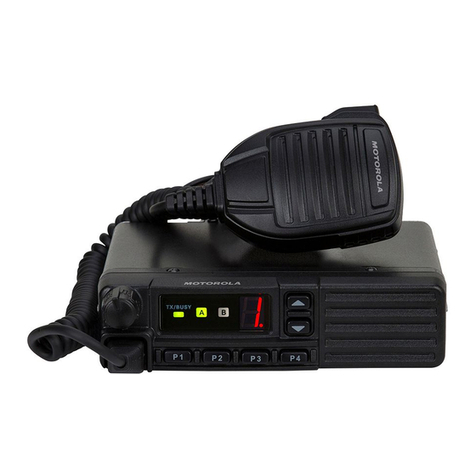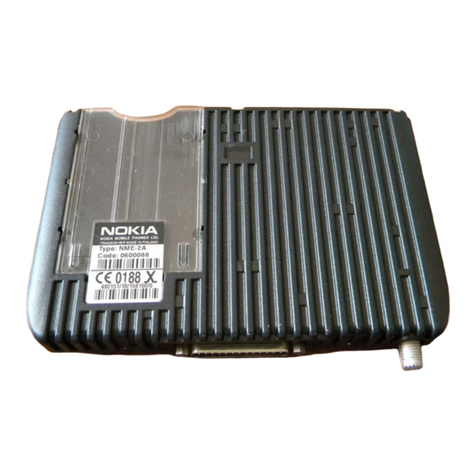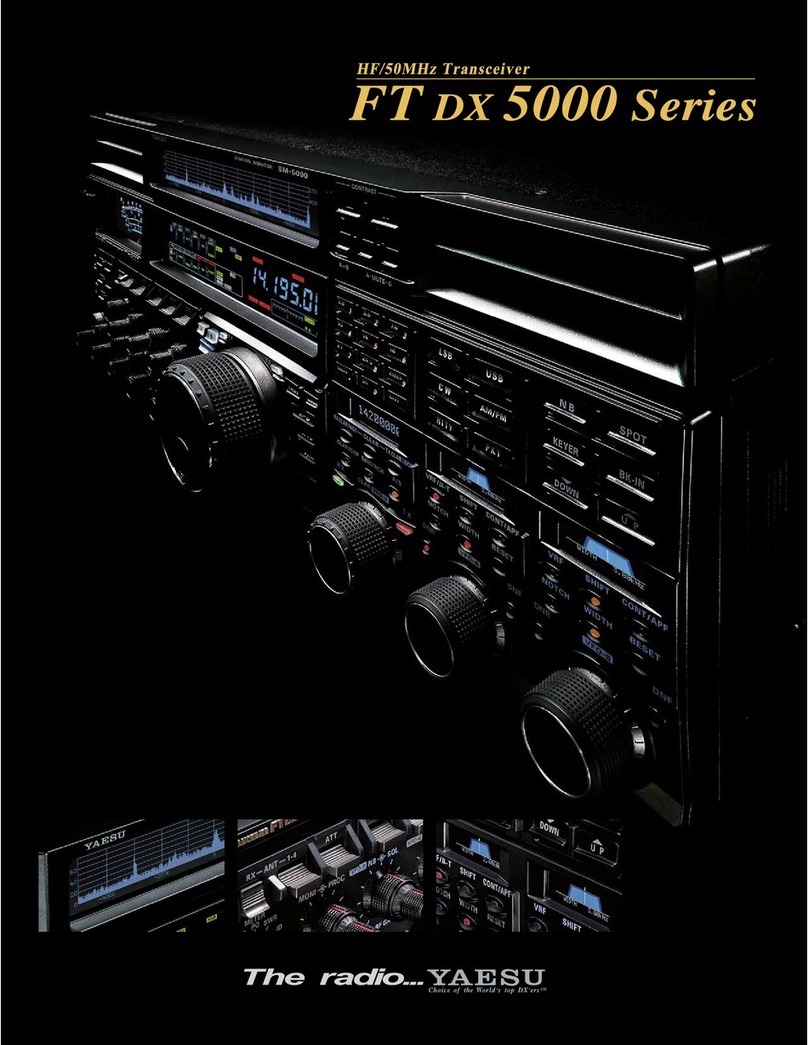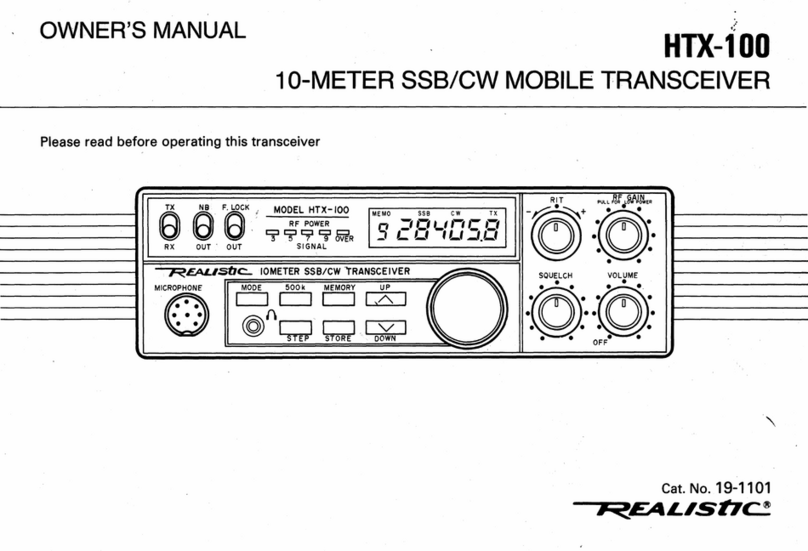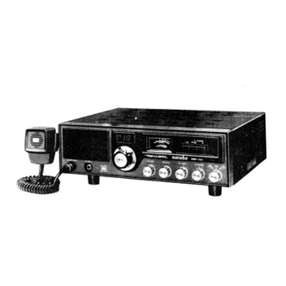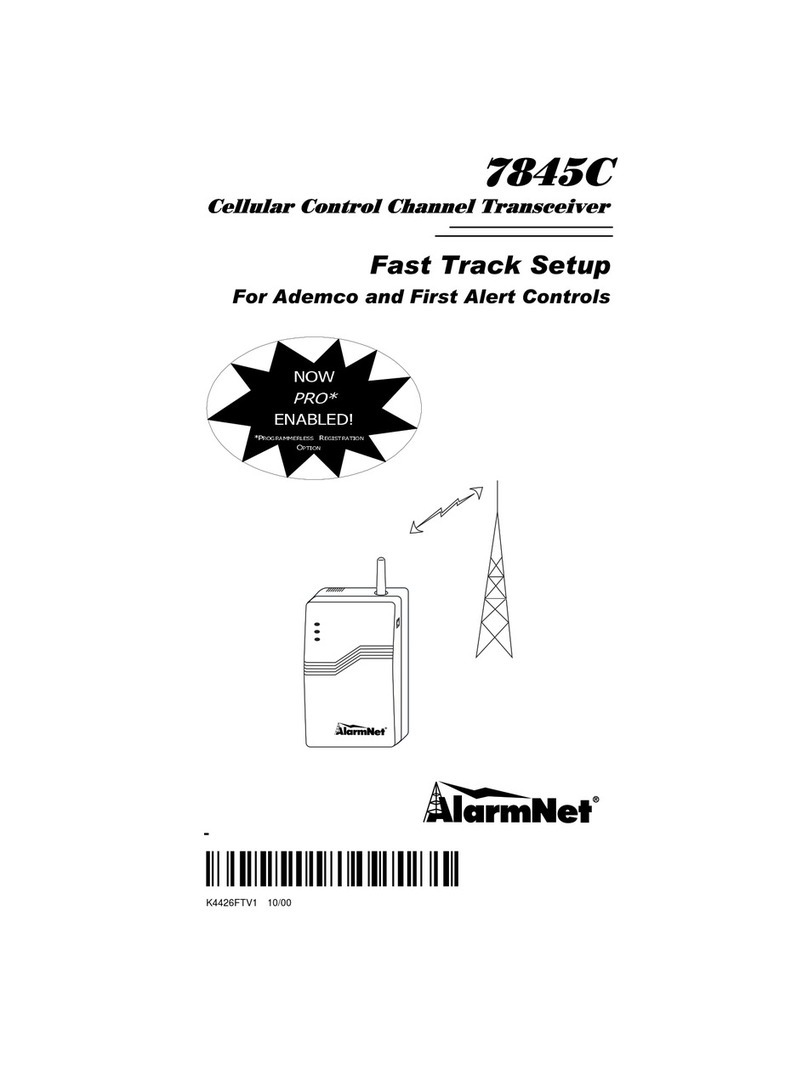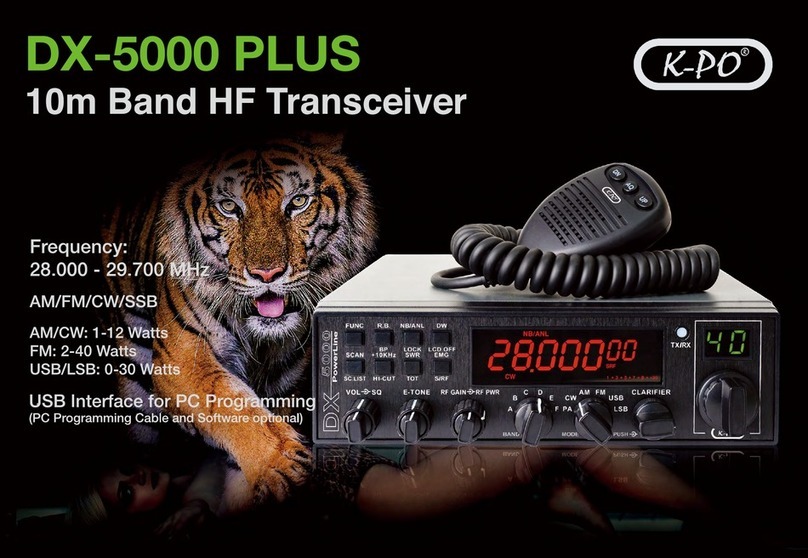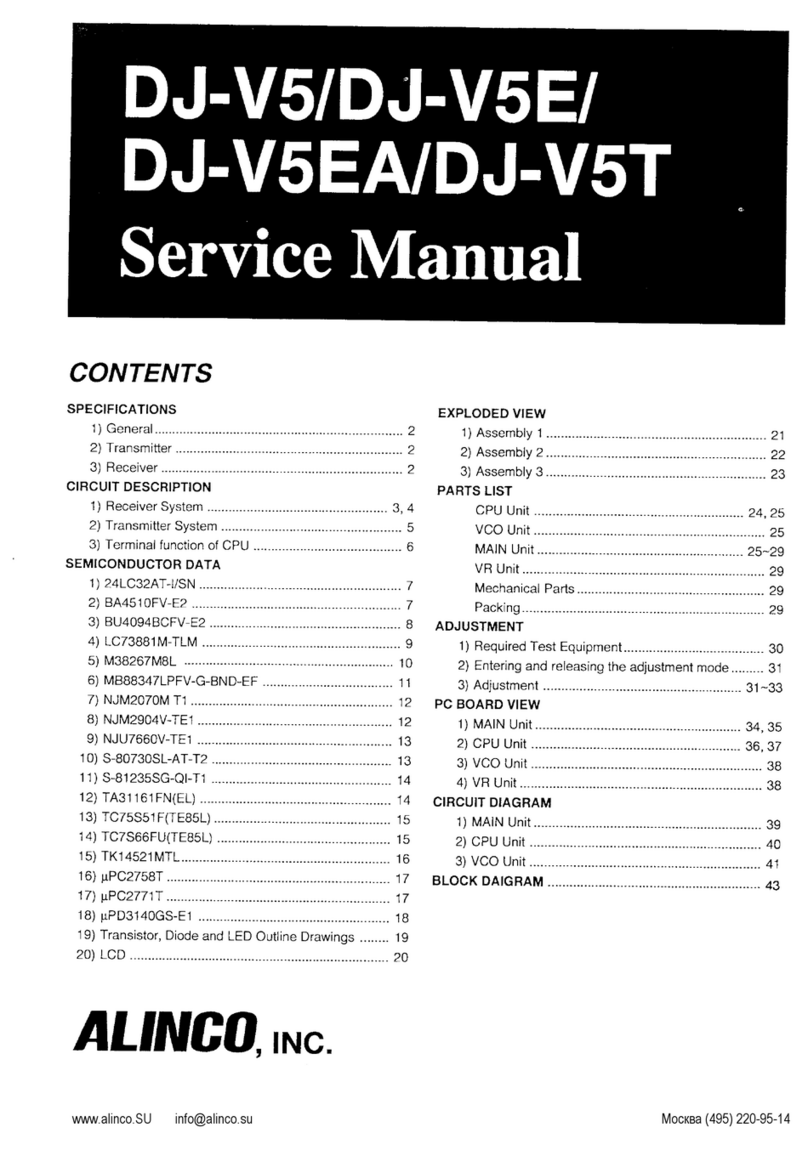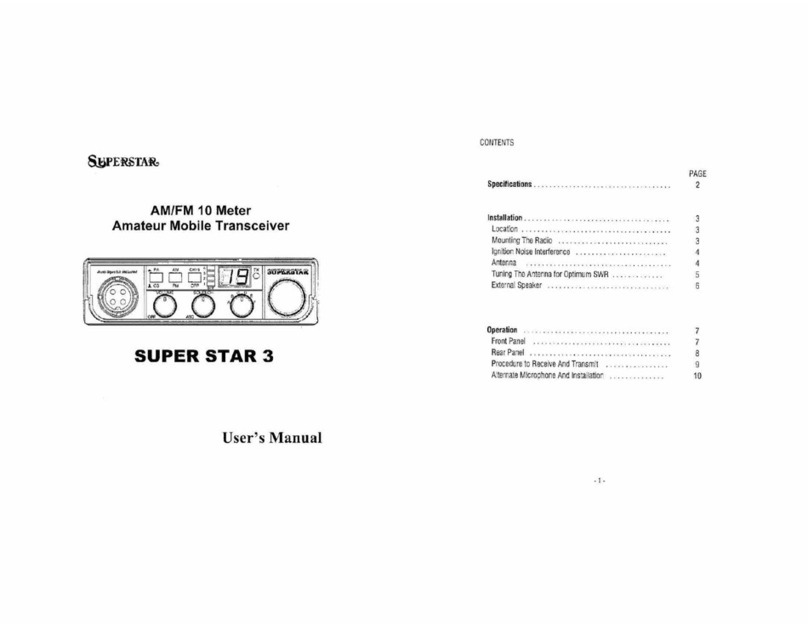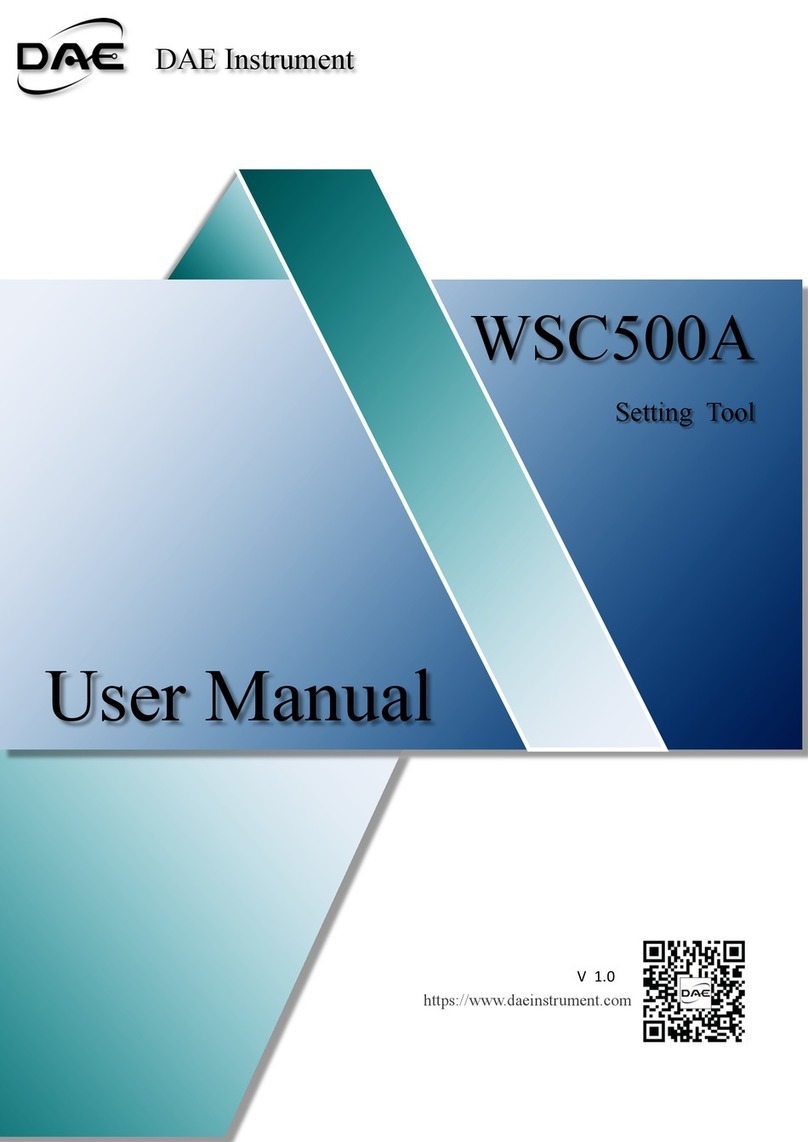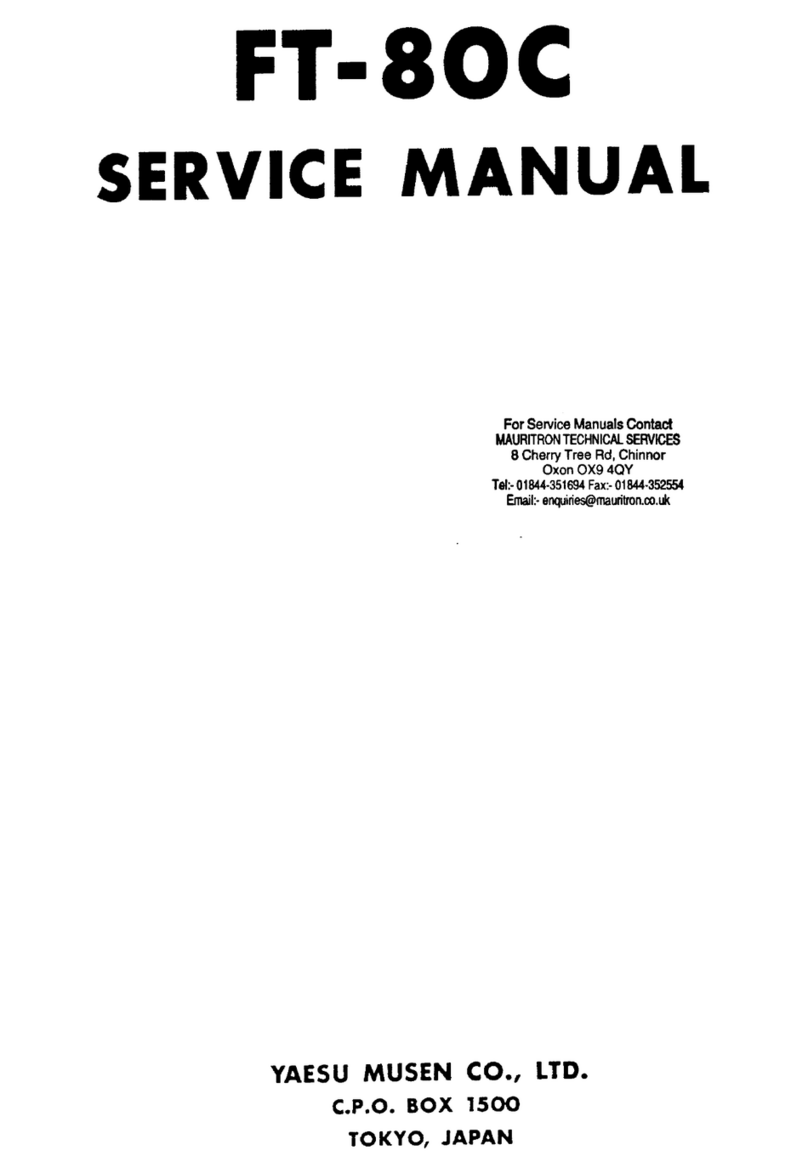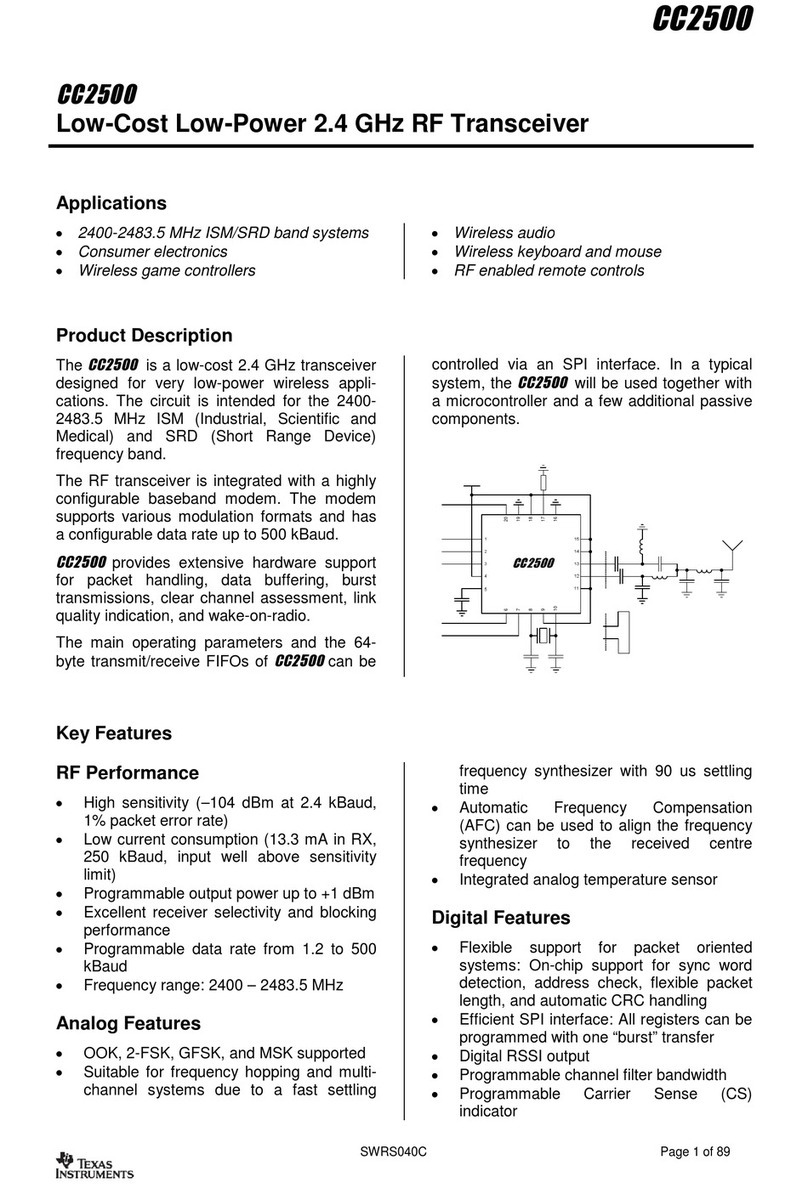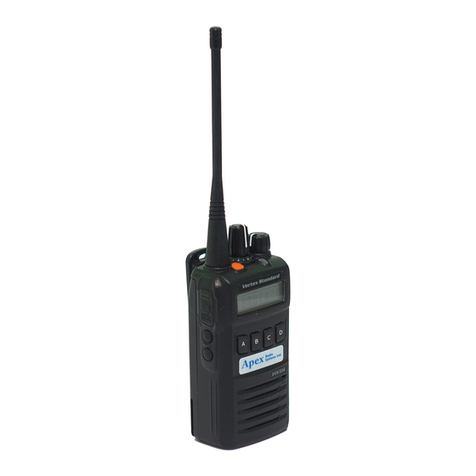Nova Engineering NovaRoam 900 User manual

Nova Engineering
NovaRoam™900
Spread Spectrum Transceiver
User’s Manual
Nova Engineering
5 Circle Freeway Drive
Cincinnati, OH 45246
513 860 3456
FAX 513 860 3535
www.nova-eng.com
© 1999 Nova Engineering, Inc. All Rights Reserved.

1.0 Introduction
Nova Engineering’s NovaRoam™ 900 is a complete direct sequence spread spectrum (DSSS) transceiver tailored
for industrial applications that operates in the 915MHz industrial, scientific, and medical (ISM) frequency band.
This product can be used for multiple access networking, point to point, or broadcast operation. The DSSS
waveform results in enhanced immunity to interference, yielding increased link reliability, especially in
congested areas. DSSS also delivers extended range since the Federal Communications Commission (FCC)
allows these devices to transmit 30dB more power than conventional ISM band radios.
This User’s Manual introduces the operator to the capabilities, features, and operation of the NovaRoam™ 900,
facilitating efficient integration into a fully functional wireless network. Technical support is available either
directly through Nova Engineering or via one of the NovaRoam™ 900 distributors.
2.0 Getting Started
Each NovaRoam™ 900 is bundled with the following items:
•NovaRoam™ 900 transceiver
•12VAC transformer
•Automobile cigarette lighter power cord
•Collinear whip antenna and integral 12’ cable
•RJ45 data cable
•Monitor port cable
•User’s manual.
The NovaRoam™ 900 is designed to accept either an AC or DC input power source. The unit receives AC
power from a standard 110VAC wall outlet via a plug-in transformer that steps the voltage down to 12VAC.
Alternatively, the NovaRoam™ 900 can operate from a DC power supply at any voltage between +10 and +20V.
This allows a car battery to serve as the power source for the NovaRoam™ 900 in mobile applications. A
cigarette lighter cord is included for this purpose.
3.0 Theory of Operation
Nova Engineering’s NovaRoam™ 900 is a complete direct sequence spread spectrum (DSSS) transceiver tailored
for industrial applications that operates in the 915MHz industrial, scientific, and medical (ISM) frequency band.
This product can be used for multiple access networking, point to point, or broadcast operation. The DSSS
waveform results in enhanced immunity to interference, yielding increased link reliability, especially in
congested areas. DSSS also delivers extended range since the Federal Communications Commission (FCC)
allows these devices to transmit 30dB more power than conventional ISM band radios.
Another compelling benefit of DSSS is that the FCC permits users to install and operate this equipment without
obtaining any special licensing whatsoever. Nova Engineering has conducted the necessary testing to receive
FCC certification for the NovaRoam™ 900. The user’s responsibility is to simply install NovaRoam™ 900 in
accordance with the guidelines supplied in the user manual. This permission is granted by the FCC with the
following stipulations in order to protect the entire community of Part 15 users by ensuring that their equipment
does not generate excessive signal levels. This also serves to guard NovaRoam™ 900 networks by preventing
harmful interference levels from other systems. It should also be noted that the NovaRoam™ 900 has been
specifically tailored to survive levels of external interference that would disable most Part 15 transceivers. This
is due in part to a receiver front end that achieves 30dB higher dynamic range than the competition.
Consequently, NovaRoam™ 900 stands the best chance of delivering reliable wireless links under adverse
conditions.
CAUTION
Changes or modifications to the NovaRoam™ 900 not expressly approved by Nova Engineering could void the
user’s authority to operate this equipment.

Nova Engineering also offers professional NovaRoam™ 900 installation at the user’s discretion. This service
provides the added performance benefit of generating a site survey to achieve the most reliable links possible.
Nova Engineering’s custom design expertise identifies the optimum RF channels, antennas, antenna heights,
operating mode, and network topology.
NOTE
This equipment has been tested and found to comply with the limits for a Class A digital device, pursuant to
Part 15 of the FCC Rules. These limits are designed to provide reasonable protection against harmful
interference when the equipment is operated in a commercial environment. This equipment generates, uses, and
can radiate radio frequency energy, and, if not installed and used in accordance with the instruction manual,
may cause harmful interference to radio communications. Operation of this equipment in a residential area is
likely to cause harmful interference in which case the user will be required to correct the interference at this own
expense.
The NovaRoam™ 900 can be configured to operate in any of seven DSSS modes with burst data rates from
21kbps to 1.008Mbps, as shown in Table 1. This broad range of nearly 50:1 enables the user to select the best
combination of throughput and range to establish a robust link. While increasing the data rate is generally
desirable in order to accelerate packet transfer, this benefit comes at the expense of decreased range. Links are
generally configured with the highest possible data rate consistent with reliable communications. Nova
Engineering has built flexibility into the NovaRoam™ 900 through these multiple DSSS modes so that a single
transceiver can close short haul links at rates exceeding 1Mbps or span distances exceeding 30km with reduced
throughput. Two types of modulation are employed, binary phase shift keying (BPSK) and quadrature phase
shift keying (QPSK), depending on the particular mode that has been selected. BPSK achieves better receiver
sensitivity than QPSK at comparable data rates, a benefit that can be used to either improve link margin or
extend the range of the NovaRoam™ 900.
The first 3 NovaRoam™ 900 modes have much narrower bandwidth than the remaining modes. While this does
result in lower burst data rates, it dramatically improves the chances of avoiding interference from other
systems. This is particularly useful in congested urban environments where there may be little opportunity to
obtain more than 1MHz of relatively unoccupied spectrum. The NovaRoam™ 900 also includes SAW IF filters
in the receiver to provide superior resistance to adjacent channel interference. The 3dB bandwidth of these
filters are 2.7MHz for the narrowband modes and 9.6MHz for the wideband modes of operation.
Table 1 NovaRoam™ 900 Modes Span Broad Range of Wireless Applications
Data 3dB Transmitter Receiver Sensitivity Processing
Mode Rate Modulation Bandwidth Power No FEC FEC Gain
121kbps BPSK 1.2MHz +23.0dBm -108dBm -109dBm 18.0dB
2 42 BPSK 1.2 +23.0 -105 -106 14.9
3 101 BPSK 1.2 +23.0 -98 -100 11.1
4 159 BPSK 4.3 +28.5 -101 -102 14.9
5 317 QPSK 4.3 +28.5 -98 -101 14.9
6 655 QPSK 4.3 +28.5 -93 -97 11.8
7 1008 QPSK 5.8 +28.5 -89 -94 11.1
The NovaRoam™ 900 operates in the 902 to 928MHz ISM band that has been authorized in accordance with
§15.247 of the FCC Rules. The transceiver includes integral frequency synthesizers that can be used to tune the
NovaRoam™ 900 to select any RF channels on a 0.5MHz grid. This enables the user to deploy the NovaRoam™
900 at a channel in the RF spectrum that is minimally congested, thereby avoiding harmful interference. If
desired, the unit can also be set up to transfer data over different channels in the forward and return links. For
instance, 910MHz might be selected to send packets from unit A to unit B while 920MHz might be used to relay
information from unit B to unit A. This degree of flexibility can be used to further reduce susceptibility to
interferers that are physically close to NovaRoam™ 900 transceivers. The 3dB bandwidth of the NovaRoam™
900 signal ranges from 1.2 to 5.8MHz, depending on the operating mode, as indicated in Table 1. Therefore even

though the RF channel resolution is 0.5MHz, the channels need to be separated by at least the signal bandwidth
when attempting to operate multiple NovaRoam™ 900 transceivers in overlapping regions.
The signal bandwidth also limits the channels that may be selected since the FCC Rules prohibit the spectrum
from extending beyond the 902 to 928MHz boundaries. Thus the narrower bandwidth signals may be assigned
channels that are closer to these limits, as shown in Table 2. The bandpass filters at the front end of the
NovaRoam™ 900 receiver also limit channel selection. Nova Engineering has deliberately selected a relatively
narrow filter bandwidth in order to block interference from neighboring frequency bands such as pagers. This
enables the NovaRoam™ 900 to establish robust links between sites that would otherwise be disabled by strong
adjacent channel interference.
The NovaRoam™ 900 transceiver antenna port mates to one of three special types of antennas and coaxial cable
assemblies. The user is cautioned against attempting to substitute antennas or cable assemblies that have not
been explicitly authorized by Nova Engineering since this could result in noncompliant performance, in
violation of the Part 15 Rules drafted by the FCC. This circumstance has led Nova Engineering to select a
nonstandard antenna port connector, RP-TNC, to prevent improper antennas and cable assemblies from being
employed. The following three configurations have been tested by Nova Engineering and approved for use
with the NovaRoam™ 900 transceiver:
1. Collinear Whip: Antenex BB8965C with Antenex GMBD magnetic mount [Nova P/N 8040-0119]
2. Omni: Antenex FG9026 with 25’ LMR400 cable assembly [Nova P/N 8040-0117]
3. Yagi: Antenex YB8966 with 100’ LMR400 cable assembly [Nova P/N 8040-0118].
A collinear whip antenna is supplied with the purchase of each NovaRoam™ 900 transceiver. The whip attaches
to a magnetic mount that includes an integral 12’ coaxial cable. The whip and magnetic mount combination is
supplied as a custom assembly by Nova Engineering, P/N 8040-0119, that includes an RP-TNC connector to
mate directly to the NovaRoam™ 900 antenna port. Orient the antenna during installation so that it stands
vertically, thereby providing an omnidirectional pattern.
The omni and Yagi antennas are selected for situations that demand extended range from the NovaRoam™ 900
transceiver. Each antenna is supplied with a special coaxial cable assembly, Nova P/N 8040-0117 or 8040-0118,
that has been designed to yield FCC compliant performance from the NovaRoam™ 900. The attenuation of each
cable assembly compensates for the increased gain of these antennas. Such cable assemblies can also be used to
elevate the antennas on masts to further increase the NovaRoam™ 900 range. Raising the antenna is one of the
most effective methods of improving marginal links. The 25’ and 100’ cable assemblies are specified for the
omni and Yagi antenna, respectively. The longer cable assembly may also be used for the omni antenna,
although this would decrease the system margin by 3dB. However, the shorter cable assembly is not authorized
for the Yagi antenna since it yields radiated RF power levels in violation of the Part 15 Rules established by the
FCC.
The omni antenna produces an omnidirectional pattern, as its name implies. This pattern is achieved when the
antenna is oriented so that it stands vertically. The Yagi antenna produces a narrow beam along the axis of the
main pole of the antenna. Consequently, the Yagi should be pointed directly toward its intended destination.
Table 2 NovaRoam™ 900 Channels
Channel Frequency (MHz)
Mode Minimum Maximum
1 906 924
2 906 924
3 906 924
4 909 921
5 909 921
6 909 921
7 909 921

The six short elements of the Yagi should be oriented vertically in order to match the polarization of other
antennas in the NovaRoam™ 900 network. The Yagi is therefore used to reject strong interference that is not
along the line of sight between the source and destination transceivers. The obvious disadvantage of employing
a Yagi is that it cannot be used when one of the NovaRoam™ 900 units is mobile. In general, omni antennas are
selected both at the master and store and forward sites of a network since they must communicate with multiple
transceivers that are dispersed throughout a region. Yagi antennas are most effective at fixed remote sites in a
master/slave network that simply need to exchange packets directly with a single node in the network.
The coaxial cable assemblies that accompany each of the NovaRoam™ 900 antennas are designed to be mated to
the antenna and the NovaRoam™ 900 antenna port. There is only one way to make this connection since the
antenna uses a Type N connector while the NovaRoam™ 900 employs an RP-TNC. The coupling nuts should
only be hand tightened. Pliers or wrenches should not be used since they might generate excessive torque,
damaging the connector interface. Once the coax has been attached to the antenna, apply a layer of Vapor-
Wrap™ around the joint at the antenna to prevent moisture in the outdoor environment from corroding this
connection. This is accomplished by removing the paper backing from the Vapor-Wrap™ and laying it against
the connector pair so that the connectors are in the center of the patch. Wrap the Vapor-Wrap™ around the
connectors and cables, pushing and working the compound into all cracks. Smooth the compound onto the
cable jacket. When complete, the joint should have a smooth, tapered appearance.
The antenna should be located so that there is a clear line of sight to every other NovaRoam™ 900 transceiver
that it intends to communicate with directly. Obstacles such as buildings and foliage generally reduce the
resulting received signal strength and thereby degrade link performance. In the case of omni and Yagi antennas,
a clear line of sight can often be achieved by mounting the antenna on a mast to obtain clearance over
obstructions. The NovaRoam™ 900 must be mounted within an enclosure to shield it from rain and condensing
humidity, reducing its exposure to the elements. Finally, remember to point the Yagi antenna in the direction of
its destination. In certain situations, minor changes in the pointing and height of the antenna can yield
noticeable improvements in link margin. Therefore be prepared to make some adjustments from the initial
settings if this advantage is needed. This is best achieved by performing NovaRoam™ 900 link tests at several
different orientations, and noting the position that delivers the best results.
CAUTION
The NovaRoam™ 900 has been specifically designed to close the longest possible links. This goal has been
accomplished in part by delivering the highest permissible RF output power to the antenna per the FCC Part 15
Rules. In August 1996, the FCC adopted RF exposure guidelines that established safety levels for various
categories of wireless transceivers. Those limits are consistent with safety standards previously published by
the National Council on Radiation Protection (NCRP) Report 86, §17.4.1, §17.4.1.1, §17.4.2, and §17.4.3 as well as
the American National Standards Institute (ANSI) in §4.1 of “IEEE Standard for Safety Levels with Respect to
Human Exposure to Radio Frequency Electromagnetic Fields, 3kHz to 300GHz,” ANSI/IEEE C95.1-1992. The
NovaRoam™ 900 user can comply with this FCC guideline by maintaining a minimum separation from any
NovaRoam™ 900 antenna of at least 9” (22.8cm). As a consequence, the user should disconnect the AC/DC
input power source from the NovaRoam™ 900 whenever repositioning the antenna.
DSSS signals, by their very nature, produce wideband spectra in order to mitigate the effects of interference. As
a consequence, these signals will tend to intermingle when multiple channels are deployed in overlapping
physical regions. Nova Engineering has devised a remedy to this challenge by allowing these networks to select
“sync sets” consisting of specially constructed PN sequences and frame synchronization preambles. These
words have been selected to have minimum cross correlation and thereby serve as passwords to limit access to a
network. A user operating within Network A cannot access channels on Network B since their passwords do
not match. The NovaRoam™ 900 includes four sync sets for each of its seven operating modes. There are
limitations to this strategy since even though access can be effectively denied in this way, it does not prevent
interference between the competing signals. As a result, it is always best to strive to obtain the widest possible
frequency separation between channels in overlapping networks.

NovaRoam™ 900 Transceiver Specification
Electrical Parameters Specification
Waveform Direct Sequence Spread Spectrum
Frequency Range 902-928MHz ISM Band
Modulation Type Differential BPSK or QPSK
Spread Bandwidth 9.0MHz or 2.1MHz (User Programmable)
Channel Spacing 500kHz
Sensitivity -101dBm at 159kbps channel burst rate for 10-5 BER
Adjacent Channel Rejection 45dB at 4.0MHz offset
IF Rejection 70dB
Image Rejection 70dB
LO Leakage -80dBm
Channel Burst Data Rate 7 Programmable Data Rates from 21kbps to 1.008Mbps
Processing Gain 11.1 to 18dB (Channel Burst Data Rate Dependent)
Data Interface Options 10Base-T (802.3 Ethernet) or RS-232
RF Output Power 1 Watt
Radio Configuration Web Browser
RT/TR Turn-Around 5.0ms Typical
Mobile Network Size 253 Nodes Maximum
Standard Antenna Configurations Specification
Collinear Whip [Nova P/N 8040-0119] +6dBi Gain with Magnetic Mount & 12’ Teflex Cable Assembly
Omni [Nova P/N 8040-0117] +8dBi Gain with 25’ LMR400 Cable Assembly
Yagi [Nova P/N 8040-0118] +11dBi Gain with 100’ LMR400 Cable Assembly
Mechanical/Environmental Parameters Specification
Dimensions 4.0”x9.5”x1.5”
Weight 1.9lb
Operating Temperature 0°C to +60°C
Extended Temperature Range (optional) -40°C to +60°C
Storage Temperature -40°C to +85°C
Humidity 95%, Non-Condensing (Operating and Storage)
Power Consumption Specification
Input Power Source +10 to +18VDC or 12VAC
Receive Mode 14 Watts Typical
Transmit Mode 18 Watts Typical
